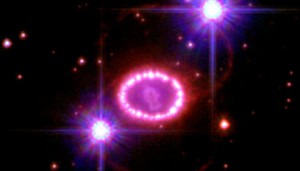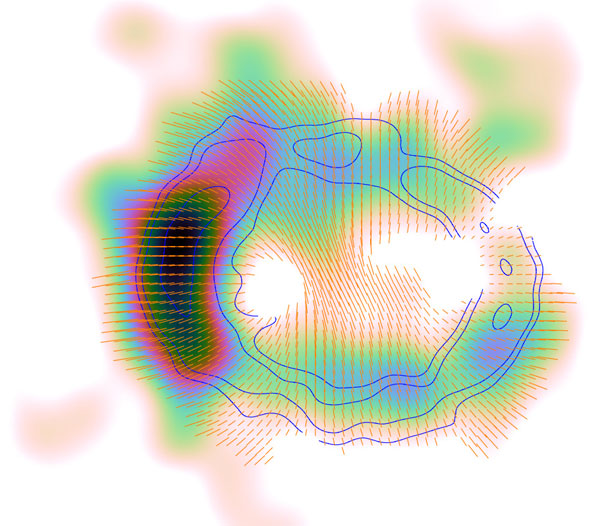Researchers have mapped the magnetic field in Supernova 1987A, shedding light on how stellar blasts act as particle accelerators.

NASA / ESA / R. Kirshner (Harvard-Smithsonian Center for Astrophysics)
Supernova 1987A was the first stellar explosion witnessed with unaided eyes in more than 400 years. Its brightness, with a peak apparent magnitude of +2.9, was due in part to its proximity, as it's located in the Milky Way's largest satellite galaxy, the Large Magellanic Cloud. In the decades since its discovery, SN1987A has provided astronomers with a practically backyard laboratory to investigate how supernovae accelerate particles to speeds undreamed of by Earthbound physicists.
Now, Giovanna Zanardo (University of Western Australia) and colleagues report the first-ever map of the magnetic field that courses through the hot gas surrounding the collapse star. The results appear in the June 29th Astrophysical Journal Letters.
The researchers collected radio waves at frequencies between 20 and 50 GHz using the Australia Telescope Compact Array and measured the waves' linear polarization, which told the researchers how the incoming radio waves were aligned. “The picture shows what it would look like if you could sprinkle iron filings over the expanding cloud of debris, 170 thousand light years away”, says study coauthor Bryan Gaensler (University of Toronto).

Giovanna Zanardo
You'd be forgiven for thinking that the magnetic field ought to align with the remnant's donut-shaped ring of heated gas — older supernova remnants often have such magnetic fields. But younger remnants — and at 31 years old, SN 1987A is the youngest known — instead host magnetic fields that poke outward like the spokes of a wheel.
While not entirely unexpected, this magnetic-field alignment also isn't entirely understood. "We have some theories as to what is going on, but there’s no firm consensus," Gaensler says.
Since the magnetic field goes all the way through the bright ring of emission, it encompasses the full range of shock waves that the supernova produced. It could be that, as particles are accelerated to high energies over the shock fronts, they amplify the magnetic field. The result is a magnetic field that's combed out all the way to the shell's edge.
Watching the magnetic fields evolve over time will give astronomers a first-hand view of how nature's particle accelerators work.
 1
1









Comments
tom-dasilva
July 2, 2018 at 12:03 pm
The dynamics of a spherical body rotating about an axis with matter at temps which separate charged particles, and a fusion reactor at the center. Simple physics of stars, eh?
You must be logged in to post a comment.
You must be logged in to post a comment.